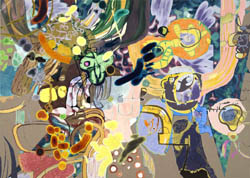

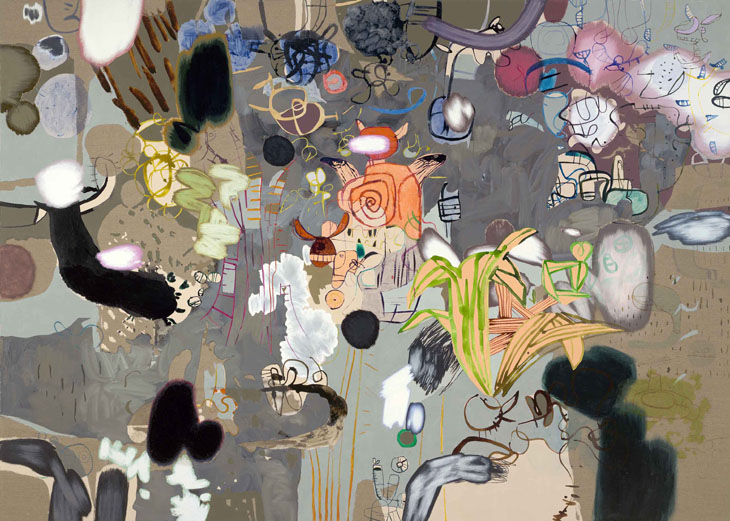
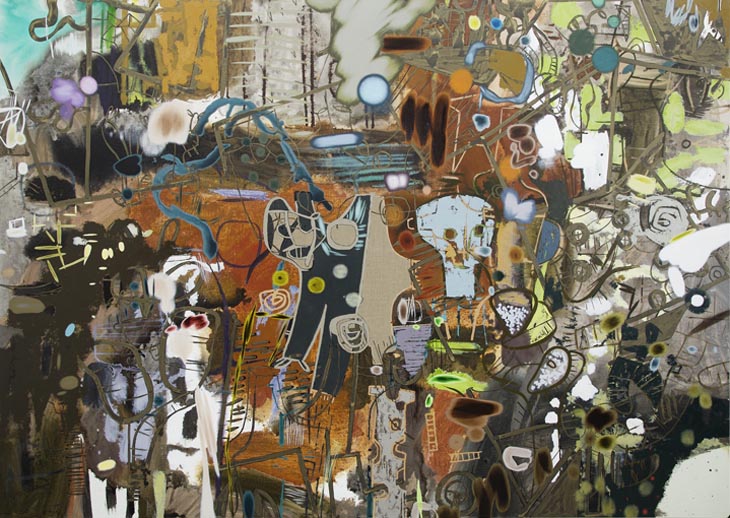
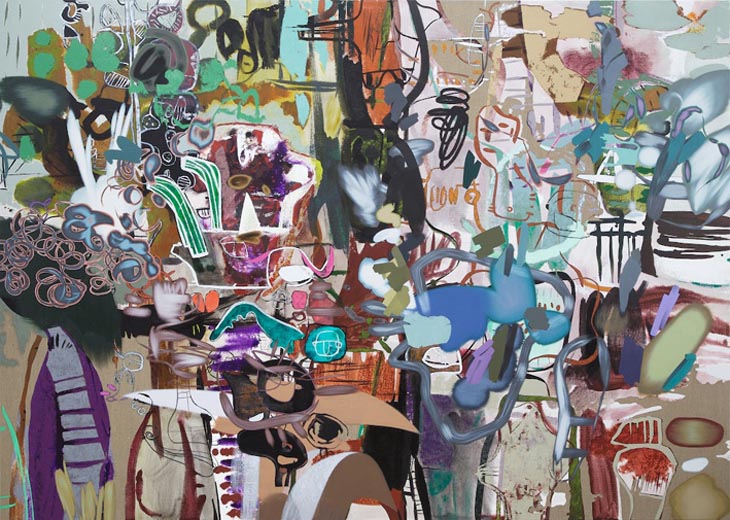
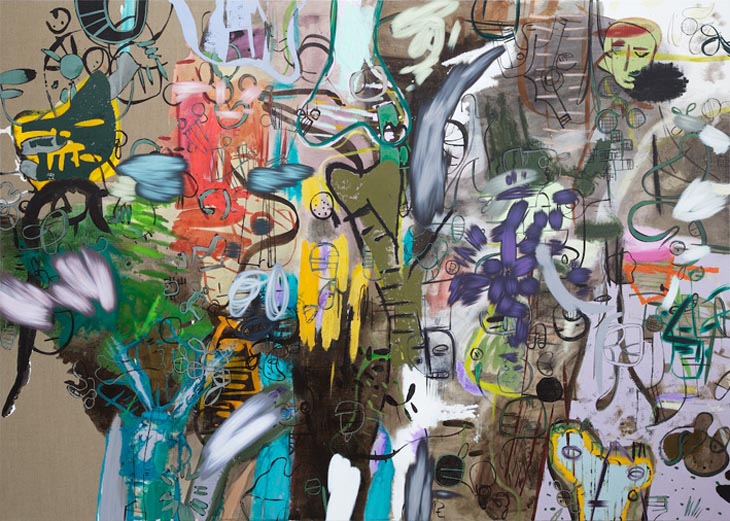
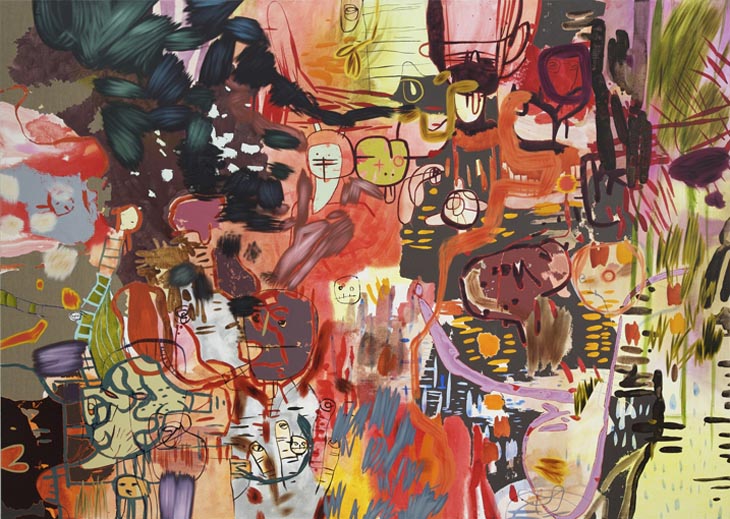
Dan Perfect
“In my paintings I am looking to build up an absolute welter of complexity. The world is an intensely complex place and it’s a great deal of work to make that feel simple and flowing. I’d like my paintings to be something like the Apple operating system – it’s a wonderful outcrop of simplicity interfacing an enormous complexity, people can engage with it immediately. There’s a simple rightness and pleasure connected to that. In a funny way my paintings are big operating systems, written in lines of visual and historical code. I’m interested in what it is to have a consistent and coherent identity. My work offers partial narratives of what constitutes you as the identifier. All the things in the pictures have some kind of a journey, a kind of nostalgia for the known: TV, comics, novels, different influences that have reached through to me. They imply a coherent personal or psychological identity, but also a wider cultural identity as well.”
“The ideas in my work are tightly bound to the physical performance of making them. My paintings are like imagined interior or psychological landscapes. You might think of them like stage sets or dramatic scenes from video games: their space doesn’t go on forever, and they have rules and parameters. They aren’t real responses to nature, but re-imagined experiences, a way of bringing the outside world into my studio. They seem quite urban and technological, and there’s a strong sense of science fiction in them. It’s a decayed science fiction where tumultuous change and biological entropy is intervened and radically altered. My paintings are full of experimentation – everything is partial: masks, costumes, body parts, animals that are human, humans that are animals, things are taken apart and exploded. History is rooted in biology but futurologists predict that we will soon be able to transcend our biology; in 50 years you may be able to upload yourself. In my paintings I’m thinking about the nature of what it is to be us in this world right now.”
Perfect’s Brujo takes its title from Carlos Castenada’s 1968 book The Teachings of Don Juan, which is an anthropological thesis often associated with hippie culture; a ‘brujo’ is a shaman or sorcerer. “All fables and stories have some purpose or resonance to them,” explains Perfect. “I like the idea of an anthropologist going out into the desert and being broken down. This painting is also influenced by Robert Bly’s writings on masculinity and ritual, expectations and inculcations. The world of the imagination is a world of magic. It’s the anthropic principle that we project our inner contents on to outer objects: canvases are objects I project on to. In this way paintings are magical things. They are powerful objects like totems or icons.”
“With each painting I try to raise my own game in the technical production. It takes two to three months to make a piece and every moment has to be important. That’s why I think of my paintings as performances. They arrive from drawings which are manipulated and re-imagined digitally, and I have to reinvest every mark with an intensity or presence. When an orchestra plays, they’re not just playing notes, they have to make it alive and animate in the moment. It’s the same with painting, each mark has to be made as if I’m inventing it for the first time, which I am. It has a lot to do with the psychology of the work: it’s not just making something, but also trying to make it interdependent with your own psychological awareness. You have to be a bit of an athlete to make a painting. You have to be aware of your own body and movement, and know what you’re like and what kind of person you are. That’s a part of the development of my work, to learn about my own capabilities.”
“My paintings require a lot of planning and technique, the manipulation of material is very time-consuming. They are extremely rich and dense, and I want them to be entertainment. That doesn’t mean glib or superficial or saccharine: the ultimate goal of making art is making something truthful that you can get swept up in. I want my work to be spectacular, in the same way orchestral music can be spectacular. My paintings are melodic and have an expansive range of timbres, subtleties, nuances, and strengths, all exaggerated in large scale. I think about these in a performative way in relation to the audience. There is a strong sense of the absurd to my work, and the dark psychological context of the surrealists is related to what I do. My work is far more tongue in cheek though, and has a comedic aspect that comes out of some of the imagery, like the cartoon characters. It’s about play, but there’s nothing more serious than play.”
“I think fantasy is conjecture not escapism, it’s a way of re-imagining the world. Paintings are virtual spaces and I think of them as being endlessly mutable places or frameworks. In my paintings I try to make something that, in the immediate moment of viewing it, has an overwhelming sense of rightness. They have an aesthetic logic indicative of a potential belief in order, if not an actual order. They’re all the time invoking chaos and dissolution, but I try to make them still and coherent as paintings. I don’t work from source imagery at all, I try to make stuff up and improvise as much as possible. I try to stop the superego intervening and not let my ‘critical other’ intervene. All the imagery formulates in a dream-like way: partial and confused narratives, the mishmash of everyday life, old memories, snippets of tunes, everything I’ve ever seen. This material doesn’t necessarily have meaning, it’s just what all the neurons in my brain are doing when they’re free-wheeling. In my paintings I try to shift, transpose, and super-organise this material into something architectural, something that has a weight about it that suggests meaning.”
“Though my paintings quote different kinds of aesthetics and textures, it’s all done with brush work. The first layer is made with water-based paint and can look like spray paint. The backgrounds are mutable and flux-like. I put sharper paint on slowly until things start to coalesce and appear out of the formlessness. I want things to emerge out of this organic mulch and build up rhythmic and density counterpoints. As artistic references I’m interested in works by Per Kirkeby, Roberto Matta, Alan Davie and Van Gogh. The titles of my paintings are indicators towards partial narrative readings and I think of them as part of the painting palette. They’re like a punctum or emotional provocateur. Village, for example – how terrifying is the word ‘village’? This painting depicts the village of the damned to some extent: it’s community, it’s cellular proximity, information interchange. It’s a lot more threatening than some of my other canvases. But it’s also quite bucolic – a happy hell.”

